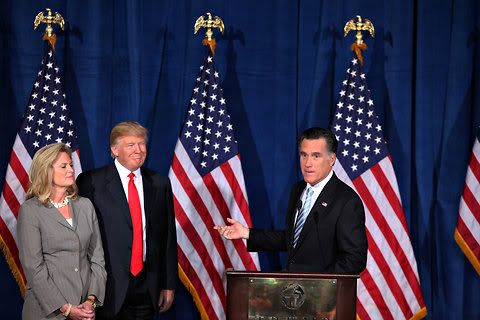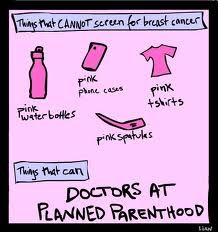“Punting the Pundits” is an Open Thread. It is a selection of editorials and opinions from around the news medium and the internet blogs. The intent is to provide a forum for your reactions and opinions, not just to the opinions presented, but to what ever you find important.
Thanks to ek hornbeck, click on the link and you can access all the past “Punting the Pundits”.
New York Times Editorial: A Painful Betrayal
With its roster of corporate sponsors and the pink ribbons that lend a halo to almost any kind of product you can think of, the Susan G. Komen for the Cure foundation has a longstanding reputation as a staunch protector of women’s health. That reputation suffered a grievous, perhaps mortal, wound this week from the news that Komen, the world’s largest breast cancer organization, decided to betray that mission. It threw itself into the middle of one of America’s nastiest political battles, on the side of hard-right forces working to demonize Planned Parenthood and undermine women’s health and freedom. [..]
In addition to harming women, the foundation has also tarnished, perhaps permanently, its brand, symbolized by the pink ribbon that adorns yogurt cups and running shoes and tote bags and Federal Premium Ammunition’s pink shotgun shells. Companies like Ford Motor, Dell and Yoplait may not find the same value in identifying themselves with the foundation after its sharp departure from political neutrality.
Paul Krugman: Romney Isn’t Concerned
If you’re an American down on your luck, Mitt Romney has a message for you: He doesn’t feel your pain. Earlier this week, Mr. Romney told a startled CNN interviewer, “I’m not concerned about the very poor. We have a safety net there.”
Faced with criticism, the candidate has claimed that he didn’t mean what he seemed to mean, and that his words were taken out of context. But he quite clearly did mean what he said. And the more context you give to his statement, the worse it gets.
President Obama’s plan for homeowner relief, announced yesterday, would allow homeowners who are current on their mortgages refinance at today’s low rates-even if they’re underwater. It could provide thousands of dollars of relief to millions of homeowners, which would also provide a boost to the economy.
However, as I mentioned yesterday, the plan falls short when it comes to principal write-downs by GSEs like Fannie Mae and Freddie Mac. The plan provides all kinds of incentives for these principal write-downs to occur, when it’s clearly in the authority of the Federal Housing Finance Agency to simply force Fannie and Freddie to write them down immediately.
The FHFA director, Edward DeMarco, has so far refused to do so, and has frequently been a target of some House Democrats for that reason. Yesterday, Representative John Conyers Jr., a powerful voice in the House Democratic caucus, praised Obama’s plan but called for immediate action on GSE write-downs
Bill Boyarsky: The Thinking Person’s Guide to Campaign 2012
Pity the poor mainstream news media, confronted with many debates, demands for instantaneous coverage, competition for website traffic and the specter of ever-multiplying Super PACs.
All these factors have changed the dynamics of the presidential campaign, putting election coverage beyond the capabilities of the news media, which has been hit hard by heavy newsroom budget cutbacks.
The loss has been severe for the nation, resulting in harried coverage too often divorced from our national struggles, including the effort to recover from the Great Recession.
David Sirota: When It Comes to Education Technology, Trust-but Verify
The release of Apple’s computer-based textbooks last month had the usual technology triumphalists buzzing. “Apple and the Coming Education Revolution,” blared the headline at Fast Company magazine. “Apple puts iPad at head of the class,” screamed MacWorld. And Time magazine declared the announcement the “debut [of] the holy grail of textbooks.” It sounds exciting-a rise of the machines that promises educational utopia rather than “Terminator”-style cataclysm.
Or does it?
Though it may be too soon to definitively answer that question, it’s not too soon to ask it. Because despite the celebratory hype, there’s no guarantee that a hyper-technologized education system is synonymous with genuine progress.
Eugen Robinson: Romney’s Indifference to the Poor
I wish Mitt Romney’s cavalier dismissal of poverty in America could be chalked up as just another gaffe, but it’s much worse than that. The Republican front-runner seems dangerously clueless about the nation he seeks to lead.
When I first heard the now-famous quote-“I’m not concerned about the very poor”-I thought it might be fodder for a snarky column about the wee little Mr. Monopoly who lives inside Romney’s head and blurts out things like “Corporations are people, my friend,” or “I like being able to fire people.” But I realized that being “very poor” is no laughing matter to millions of Americans.
Putting Romney’s words in their full context makes them worse. Here is what he said on CNN:
“I’m in this race because I care about Americans. I’m not concerned about the very poor. We have a safety net there. If it needs repair, I’ll fix it. I’m not concerned about the very rich, they’re doing just fine. I’m concerned about the very heart of America, the 90, 95 percent of Americans who right now are struggling.”
For my part, I’m concerned about what sounds like shocking ignorance about the extent of poverty in this country and an utter lack of urgency about finding solutions.
Ben Adler: Sheldon Adelson Against Disenfranchisement in Nevada Caucus
Caucuses are offensively anti-democratic affairs. They require participation in a specific time and place, preventing anyone who may be unavailable from exercising their rights as a citizen. (Typically there is no absentee voting in caucuses.) People with disabilities, college students, single parents and people who work unusual shifts are among the most common victims. In Nevada’s caucus, we’ve discovered another: observant Jews. The Nevada caucus is on Saturday.
Nevada’s Republican Party, to its credit, has created an absentee voting mechanism in the caucuses for members of the military. As I’ve previously reported, there is a movement within the Republican Party to encourage or require state parties to allow absentee voting in caucuses for military personnel who are stationed out of state. Iowa chose not to do so, but Nevada did.
This raises the question of why anyone else who cannot be at a caucus site at 9 am on Saturday is not simply allowed to vote absentee the way military service members can. Apparently, Nevada Republicans think democracy is only a necessity for the military. Call it another Republican military exception, like the notion that government-provided health insurance is a moral obligation for veterans and an unpleasant burden for anyone else.
John Nichols: How Scott Walker and ALEC Plotted the Attack on Arizona’s Unions
Two days after Ohio voters overwhelmingly rejected Governor John Kasich’s anti-labor agenda by a sixty-one to thirty-nine margin in a statewide referendum, Wisconsin Governor Scott Walker jetted to Arizona to launch the next front in the national campaign to attack union rights. [..]
“We need to make big, fundamental, permanent structural changes. It’s why we did what we did in Wisconsin,” declared Walker, who at the annual dinner of the right-wing Goldwater Institute said that compromising with unions was “bogus. [..]
This week, Arizona Governor Jan Brewer-fresh from pointing her finger in the face of President Obama-and her allies in the Republican-controlled state legislature announced that they would try to outdo the anti-labor initiatives of Walker and Wisconsin’s Republican legislators.
And they did so in conjunction with the very people Walker has consulted with, spoken to and urged on in November: The Goldwater Institute.


 Since of the Susan G. Komen for the Cure charity’s decision to eliminate funding to Planned Parenthood for breast cancer screenings, the Komen foundation has come under not just criticism for abandoning many women’s only option for breast cancer screening but it has brought to light some very ugly truths about the organization. The most critical one is that its pink ribbon campaign has done more harm than good. As
Since of the Susan G. Komen for the Cure charity’s decision to eliminate funding to Planned Parenthood for breast cancer screenings, the Komen foundation has come under not just criticism for abandoning many women’s only option for breast cancer screening but it has brought to light some very ugly truths about the organization. The most critical one is that its pink ribbon campaign has done more harm than good. As  On this day in 1925,
On this day in 1925,  At the January 24 meeting of the board of health superintendent Mark Summers of the Hammon Consolidated Gold Fields proposed a dogsled relay, using two fast teams. One would start at Nenana and the other at Nome, and they would meet at Nulato. His employee, the Norwegian
At the January 24 meeting of the board of health superintendent Mark Summers of the Hammon Consolidated Gold Fields proposed a dogsled relay, using two fast teams. One would start at Nenana and the other at Nome, and they would meet at Nulato. His employee, the Norwegian  Although you’d never know it if you looked out your window here in the Northeast and throughout a good part of the northern hemisphere, we are nearing the midpoint between winter solstice and the vernal equinox. The Sun is noticeably rising earlier and setting later. It is a pleasure to take my early morning shower in daylight and start dinner preparation with daylight still illuminating the kitchen. There are seed catalogs arriving in the mail which has me contemplating the flower beds, the herb garden and maybe this year some vegetables.
Although you’d never know it if you looked out your window here in the Northeast and throughout a good part of the northern hemisphere, we are nearing the midpoint between winter solstice and the vernal equinox. The Sun is noticeably rising earlier and setting later. It is a pleasure to take my early morning shower in daylight and start dinner preparation with daylight still illuminating the kitchen. There are seed catalogs arriving in the mail which has me contemplating the flower beds, the herb garden and maybe this year some vegetables.  The symbols are ewes and lambs since Imbolc is derived from a Celtic word, “oimelc”, meaning ewe’s milk. Many of the foods that are serves are lamb, cheese, poppyseed muffins, cakes and breads. Dishes are seasoned with bay leaves and dried basil.
The symbols are ewes and lambs since Imbolc is derived from a Celtic word, “oimelc”, meaning ewe’s milk. Many of the foods that are serves are lamb, cheese, poppyseed muffins, cakes and breads. Dishes are seasoned with bay leaves and dried basil. Non-Pagans celebrate February 2nd as Ground Hog’s Day, a day to predict the coming weather, telling us that if the Groundhog sees his shadow, there will be ‘six more weeks’ of bad weather. It actually has ancient roots, weather divination was common to Imbolc, and the weather of early February was long held to be a harbinger of spring. On Imbolc, the crone
Non-Pagans celebrate February 2nd as Ground Hog’s Day, a day to predict the coming weather, telling us that if the Groundhog sees his shadow, there will be ‘six more weeks’ of bad weather. It actually has ancient roots, weather divination was common to Imbolc, and the weather of early February was long held to be a harbinger of spring. On Imbolc, the crone
Recent Comments